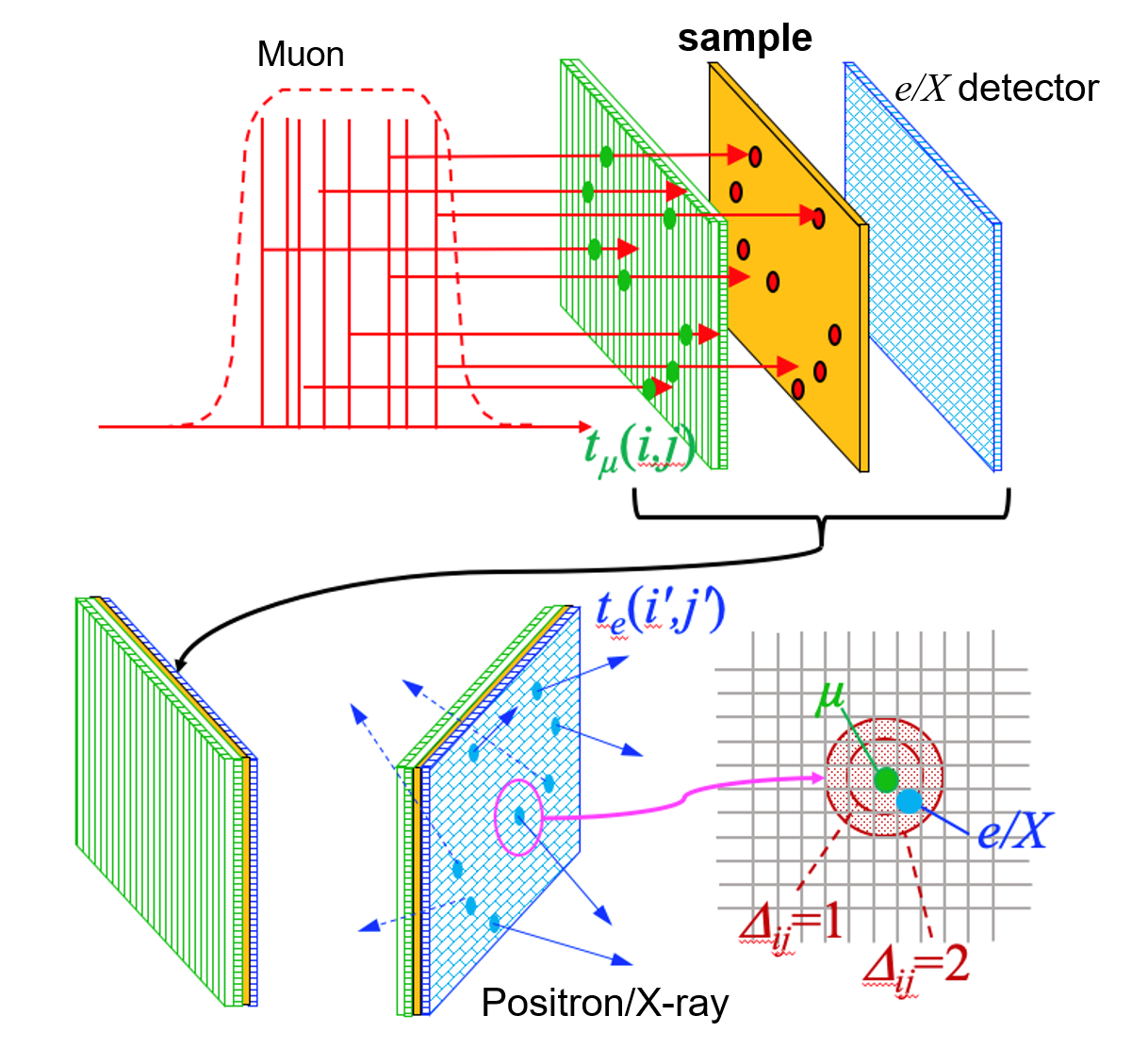| Program D01-7 | New development of pulsed beam experiments by real-time image correlation analysis |
|---|---|
| Principal Investigator | KADONO, Ryosuke (High Energy Accelerator Research Organization (KEK)) |
[Research Goals] In order to overcome the most serious
limitation of pulsed muon
experiments, which is the difficulty in identifying the
correspondence between the incident muon and the subsequent
measurement events such as electrons, positrons, and negative muon
capture X-rays, the time and position of each muon in the beam pulse
are detected with a two-dimensional detector (hodoscope) that
transmits muons. In addition, the time and two-dimensional positional
information of subsequent events from muons stopped in the sample is
measured with a pixel detector, and a one-to-one correspondence
between events is identified by correlating these two two-dimensional
images. We apply this method to muon spin rotation (μSR)
measurements, where the subsequent event is a decaying positron, to
realize μSR measurements with high temporal resolution that is not
limited by pulse width. Furthermore, we will verify the possibility
of spatially resolved nondestructive elemental analysis by combining
this method with a slow negative muon whose trailing event is a
characteristic X-ray. Through these experiments, we will demonstrate
the principle of high temporal and positional resolution measurement
using pulsed muon beams while taking advantage of the high intensity
beam.

Fig. 1. Principle of the Real-time Image Correlation Analysis
(RICA) method.
[Research Plan]
Using the μSR experiment as the main model case, we are planning the
following experiments in cooperation with C01 group. A flat specimen
with a thickness of about 1 mm, which is typical for surface (slow)
muon beam irradiation experiments, is prepared and sandwiched closely
between two two-dimensional detectors. The two-dimensional detector
at the front of the sample is a hodoscope (a detector that can
transmit a surface muon beam and measure the position and time of its
passage), which records the transmission time and position
information for every muon in the pulse during beam irradiation
(real-time muon image). A two-dimensional detector placed on the back
of the sample records the time and position information of decay
electrons/positrons, and the position and energy information of
X-rays (real time subsequent event image). Finally, the positional
correlation between the muon image and the subsequent event image is
analyzed, and the time difference between the muon and the subsequent
event is histogrammed or the information corresponding to the energy
is recorded for the pairs that are judged to correspond to the muon
and the subsequent event. In this study, this is called the Real-time
Image Correlation Analysis (RICA) method.
By adapting the RICA method, μSR involves the detection of muon decay
at each event by a small pair of muon and positron
counters. Therefore, the μSR measurement which is essentially
equivalent to that of a DC muon beam can be realized for a pulsed
beam. For the two-dimensional hodoscope through which the muon
penetrates, we used a plastic fiber (0.1 mmφ cross section), an
avalanche photodiode for readout (128×128 pixels equivalent), and a
silicon pixel detector for positron imaging (ToA mode operated
TimePix3 implemented in the readout integrated circuit, 55 μm pitch,
256×256 pixels equivalent) is applied for positron imaging. Since
both the hodoscope and the silicon pixel detector are expected to
have a time resolution of about 1.5 ns, the observation of rotation
signals of up to 300 MHz can be realized. In the first year of the
project, we will conduct a proof-of-principle study of the RICA
method for the μSR experiment using pure iron (48.7 MHz rotation
signal at zero field at room temperature) and quartz (144 MHz
rotation signal at 10 mT at room temperature), assuming the muon beam
intensity at J-PARC. In the second year of the project, we will
optimize the method for practical use by addressing the problems
identified in the previous RICA-μSR study. In addition, we will
change the operation mode of TimePix3 so that it can read signals
proportional to the energy imparted to silicon. By combining this
with a slow negative muon beam, we will measure the energy of
characteristic X-rays corresponding to negative muon injection
events, and verify the possibility of nondestructive analysis of
light elements with spatial resolution by the RICA method.
Members
- Principal Investigator
-
KADONO, Ryosuke

(Institute of Materials Structure Science, High Energy Accelerator Research Organization (KEK-IMSS))
- Research Collaborators
-
KANDA, Sohtaro (High Energy Accelerator Research Organization (KEK))
TAKAHASHI, Tadayuki (The University of Tokyo (Kavli IPMU))
Reference Materials
-
R. Kadono ,I. Watanabe ,K. Ishida ,T. Matsuzaki , andK. Nagamine , “Development of a new μSR spectrometer ARGUS,” RIKEN Accel. Prog. Rep. 29, 196 (1995). -
K. M. Kojima ,T. Murakami ,Y. Takahashi ,H. Lee ,S. Y. Suzuki ,A. Koda ,I. Yamauchi ,M. Miyazaki ,M. Hiraishi ,H. Okabe ,S. Takeshita ,R. Kadono ,T. U. Ito ,W. Higemoto ,S. Kanda ,Y. Fukao ,N. Saito ,M. Saito ,M. Ikeno ,T. Uchida ,and M. M. Tanaka , “New μSR spectrometer at J-PARC MUSE based on Kalliope detectors,” J. Phys. Conf. Ser. 551, 012063 (2014). -
R. Kadono ,K. H. Satoh ,A. Koda ,K. Nishiyama ,and M. Mihara , “High transverse field μSR with π/2-RF pulse spin control technique,” Physica B 404, 996–998 (2009).
